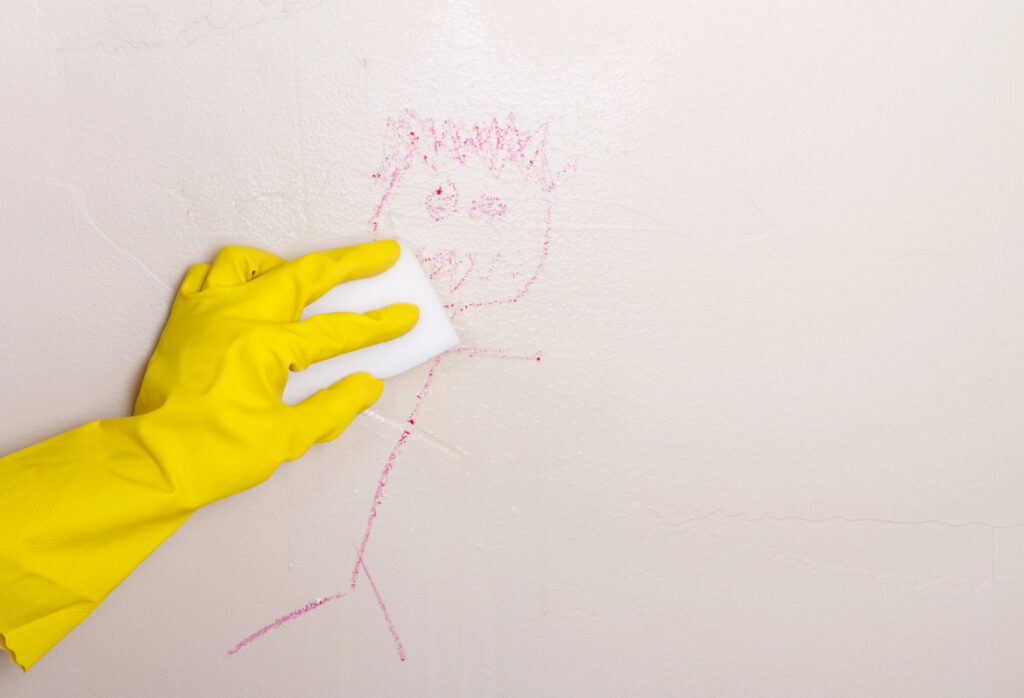
How To Clean Painted Walls
Cleaning your walls often gets overlooked amidst other household chores, but a clean wall can transform a dull room into a fresh and inviting space. If you’re unsure about where to begin when it comes to cleaning your walls, don’t fret—Hughes Painting is here to lend a hand! We’ve put together some straightforward tips and guidance to help you maintain spotless and radiant walls.
Understanding Your Paint
Before diving into the cleaning process, it’s crucial to identify the type of paint and finish adorning your walls. Different paint types require distinct cleaning methods, so it’s essential to know what you’re dealing with.
Flat, Eggshell, or Satin:
These finishes are less resilient and require gentle cleaning.
Avoid using harsh chemicals, degreasers, or excessive scrubbing, as these finishes are more prone to wear and tear.
Semigloss or Glossy:
High-traffic areas like kitchens and bathrooms typically feature this type of paint due to its durability.
Although more robust, these finishes can still be susceptible to scratches and scuffs, so handle them with care and use a soft sponge.
Latex and Oil-Based Paint:
These paints are relatively durable and can be cleaned with a mild, nonabrasive cleaner mixed with warm water.
Ensure that you use a soft sponge and avoid aggressive scrubbing to prevent accidental paint removal.
Choosing the Right Cleaning Solution
For an initial cleaning, begin with warm water and a slightly damp soft sponge or microfiber cloth. If persistent grime remains, consider using a more potent cleaning solution. You can easily create your own cleaning solution at home! Just mix a teaspoon of undyed liquid dish soap with ¼ teaspoon of white vinegar into one quart of warm water. This solution works wonders for semigloss or glossy finishes. If you’re dealing with latex and oil-based paints, you can enhance the cleaning power by substituting vinegar with ammonia.
If you’re concerned about potentially damaging your paint or finish, test your cleaning solution in an inconspicuous area, such as behind furniture or behind wall art.
Preparation is Key
To prepare for the cleaning process, start by removing all hanging wall art or pictures and shifting furniture away from the walls. Lay down towels, drip cloths, or newspapers to safeguard your floors from any potential drips. Thoroughly dust your walls, paying special attention to textured surfaces, as they tend to accumulate dust and particles.
Next, gather your cleaning supplies, including a large soft sponge or a microfiber cloth. Avoid using dyed sponges to prevent staining and consider wearing kitchen or cleaning gloves if you have sensitive skin. Lastly, prepare two buckets—one with the cleaning solution and another with clean, warm water for rinsing your sponge or microfiber cloth.
Let’s Get Cleaning!
Start cleaning from the top left-hand corner of the wall and work your way down using gentle, circular motions. Ensure that your sponge or cloth isn’t overly saturated to prevent water from trickling down the walls. After treating each area with the cleaning solution, go over it once more with fresh, clean water to eliminate any residual cleaning residue. For those hard-to-reach high walls, a sponge mop with a long handle can be quite handy.
Once you’ve finished cleaning the walls, give them a final wipe-down with a clean, completely dry sponge or towel to expedite the drying process. Allow sufficient time for your walls to air dry thoroughly before returning furniture and wall art to their original positions.
Spot Cleaning
For stains on your wall, it’s best to address them promptly. Start by gently blotting the stain with a water-dampened sponge or cloth to remove any loose debris and test if the stain can be removed without the use of cleaners.
If the stain persists, try dampening a cloth or sponge with baking soda and gently scrubbing the area. You can also create a paste by mixing baking soda and water and apply it to the stain. If these methods prove ineffective, consider using a stronger cleaner (after testing a hidden spot) and then wipe the area clean with a sponge or towel to remove any lingering cleaning residue.
Spot Painting Your Walls
If your cleaning efforts fall short, or if you accidentally remove some paint while cleaning, you may need to perform spot painting to touch up the affected areas. Whenever possible, use the original paint from your walls. If you need to purchase new paint, ensure that it matches the color, type, and finish of the original.
When applying the paint, follow the same method as the initial application, whether it’s with a brush or a roll-on. Blend the paint seamlessly into the existing coat by feathering it on to prevent the formation of thick spots or drips.
Ready for a Fresh Look? If your walls require more than just cleaning, and you’re considering a fresh interior look, don’t hesitate to reach out to Hughes Painting. We specialize in interior painting in Virginia Beach and can help you create a new, uplifting, and inviting space tailored to your preferences. Let’s revamp your home together! Contact us today to learn how we can assist you with your interior painting needs.
[facebook-reviews-pro page_name="Hughes Painting, Inc." page_id=180657965601074 page_access_token=EAAVVPjFKgSEBAFdQ9Ukc6RflTux3ZBGFZCJPgdPi2TgHQNRc39p3ZAGRw63nGJ6YrXub9zDSD1Dz0ees4wNxQV0C9z4VZAd7PGbWO8Jeo9vKMJYKVYLjWzQV578DQdeqknJ531VnSUVTTrkCVDp6Jme0L8x4X2kQoYlot6ClEvydIytu3VB8bAdQW0t3lLsZD rating_snippet=true pagination=5 text_size=120 view_mode=badge_inner open_link=true nofollow_link=true show_success_api=true lazy_load_img=true cache=24]
Request Your Quote!

